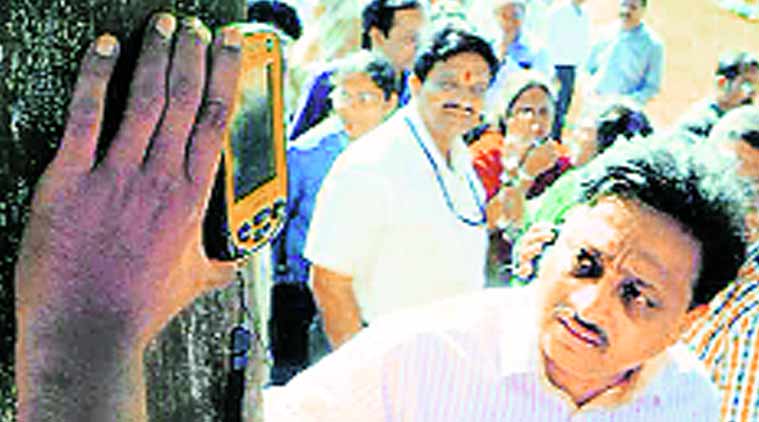- India
- International
Tree census: 40 per cent rise in number of trees in 12 wards; report includes dead trees
The tree census will cost the BMC Rs 2.7 crore and is likely to end by October.
 The tree census that was launched in February last year will cost the BMC Rs 2.7 crore and is likely to end by October. (Source: Express Archive)
The tree census that was launched in February last year will cost the BMC Rs 2.7 crore and is likely to end by October. (Source: Express Archive)The number of ‘trees’ in the island city and parts of Matunga, Parel, Malad, Goregaon areas totalling 12 wards has seen a 40 per cent rise from the 2008 census, according to the latest interim status report of the ongoing tree census in city.
“Our efforts to save trees and plant more trees have borne results and the number of trees are significantly higher than they were in 2008,” said Vijay Hire, superintendent of gardens.
In the 12 wards that include mixed habitats like Colaba, Fort, stretches of P’Dmello and Carnac Bunder, Chandanwadi, Grant Road, Malabar Hill, Byculla, Reay Road, Matunga, Parel, Malad, Goregaon, Oshiwara, Chembur and Elphinstone, till December 27 the count was 10,32,636 trees as compared to 7,35,692 trees in 2008.
The BMC’s garden department is flaunting these figures as their 2008 tree census report showing 19.17 lakh trees in Mumbai had sparked controversy.
The final report had included 33,202 dead trees and 1.59 lakh subabhul trees, a foreign species known to be weeds and invaders, that led to environmentalists demanding change in methodology during a tree census. However, these “optimistic” figures this year too include number of dead trees, admitted the surveyors.

“Our work is to survey all trees and the final report after analysis will mention the number of weak, dead and diseased trees in each ward,”said the surveyors. Moreover, the BMC also said that a tree should have a “woody stem or trunk of 10-cm (four-inch) perimeter at the chest level of an average-height person’’ but does not mention a canopy or leaves.
“The ongoing survey may present a more realistic figure because of the use of GPS, but it is hard to say if the number itself has gone up, as the last survey was a flawed one. Several trees were missed because they could not be identified and not all trees were physically checked in 2008 census. However, this survey is bound to see an increase because there were more tree plantations and better survey, but to call it a drastic increase in number of trees in the city may not be correct,” cautioned Marseline Almeida, taxonomist.
While most other wards showed an increase in the number of trees by over 50 per cent, only Chembur and Elphinstone areas surveyed until last week of December showed an approximately 79 per cent and 50 per cent decrease in the number of trees, when compared to the 2008 census.
“The actual number of living and healthy trees is what matters to the city. We can see the number of rain trees dying in the city, mainly because of haphazard cementing around roots. But this survey will show a more realistic picture of existing trees in city as compared to the last survey,” said D Stalin, environmentalist.
But surveyors stress that the survey in these two wards is not complete and may not reflect final figures. “We struggle with permission in sensitive areas because we need to physically touch each tree and using our GPS equipment, which is a bone of contention,” said a botanist and one of the surveyors, who did not wish to be named. In their report, the surveyors state the the census is ongoing in naval areas in Colaba, but is on hold in sensitive areas such as HPCL terminal, air force areas, CISF and Mint colonies and homes of select diplomats in D ward.
Since February 2014, around 40 ‘enumerators’, including surveyors and botanists, have recorded information of trees as part of Brihanmumbai Municipal Corporation’s (BMC’s) tree census.
For the first time during the tree census, surveyors will use Trimble GPS units to note the exact location of a tree. Besides the location and girth, information such as the tree’s canopy diameter and type mentioned in the 2008 census, the new census report will include the tree’s condition (whether weak, diseased or dead) as well as the carbon sequestration potential (potential to trap atmospheric carbon dioxide). Special remarks indicating whether the tree was mechanically cut or had been uprooted or whether it has a cement collar around it, will also be included in the report. Photos of rare species, trees of “heritage and cultural value” as well as endangered species will be available after the census is done.
This information along with a unique ID for each tree with its characteristics will be superimposed on the civic body’s geographic information system (GIS) map. While citizens can zoom in on the map to get the basic details, junior tree officers in each ward can access the entire data on the tree using a code, according to the gardens department.
The census will cost the civic body Rs 2.7 crore and is being conducted jointly by Mumbai-based SAAR IT Resources and Nagpur-based Apex Spatial Tech Solutions. It is likely to be completed by October this year.
Must Read
Apr 23: Latest News
- 01
- 02
- 03
- 04
- 05






































